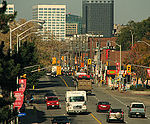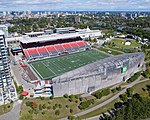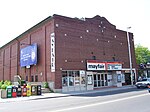The Glebe is a neighbourhood in Ottawa, Ontario, Canada. It is located just south of Ottawa's downtown area in the Capital Ward. According to the Glebe Community Association, the neighbourhood is bounded on the north by the Queensway, on the east and south by the Rideau Canal and on the west by LeBreton Street South, Carling Avenue and Dow's Lake. As of 2016, this area had a population of 13,055. This area includes the Glebe Annex, an area west of Bronson Avenue, north of Carling Avenue, east of LeBreton South Street and south of the Queensway, that maintains its own neighbourhood association - the Glebe Annex Community Association (GACA). The Glebe also includes the Dow's Lake neighbourhood, an area north of the Rideau Canal, east of Dow's Lake, south of Carling Avenue and west of Bronson, that maintains its own neighbourhood association - the Dow's Lake Residents Association (DLRA).
The Glebe has a strong community association which, in addition to running a large community centre, lobbies the local government on issues such as traffic calming and neighbourhood development. The Glebe has a community newspaper, Glebe Report, that has been published independently since 1973.
The Glebe is mostly populated by families; the area has many children, and consequently its social services are oriented towards youth. The Glebe lies in the federal riding of Ottawa Centre, and the same provincial electoral district.
The stretch of Bank Street that runs through the Glebe is one of Ottawa's premier shopping areas, with many small stores and restaurants offering a wide variety of services. Much of the rest of the Glebe consists of detached homes, many of them constructed in the early decades of the 20th century. Some of these homes are owner-occupied family residences, while others have been subdivided into multiple rental apartments.
The Glebe is home to Lansdowne Park which contains TD Place Stadium, where Ottawa's Canadian Football League (CFL) football team (the Ottawa Redblacks) and the University of Ottawa Gee-Gees play their home games. Lansdowne Park also contains TD Place Arena, which is the permanent home of the Ottawa 67's and was the temporary home (1992–1995) for the Ottawa Senators before the Canadian Tire Centre (originally called The Palladium) was completed. The area that became the park was purchased from local farmers in 1868 by the City of Ottawa Agricultural Society.
From the Rideau Canal, two bodies of water jut into the Glebe: Patterson Creek and Brown's Inlet. These areas are surrounded by parks and some of the city's most expensive homes.
The last Saturday in May of each year brings the "Great Glebe Garage Sale" to the neighbourhood; every household that participates puts items out for sale, attracting a large contingent of bargain hunters to the area. Sellers are expected to donate a portion of the proceeds to a designated charity.
May is also the time of the national capital's Tulip Festival. The largest tulip beds in the National Capital Region are found in Commissioner's Park in the Dow's Lake neighbourhood, next to Dow's Lake.











